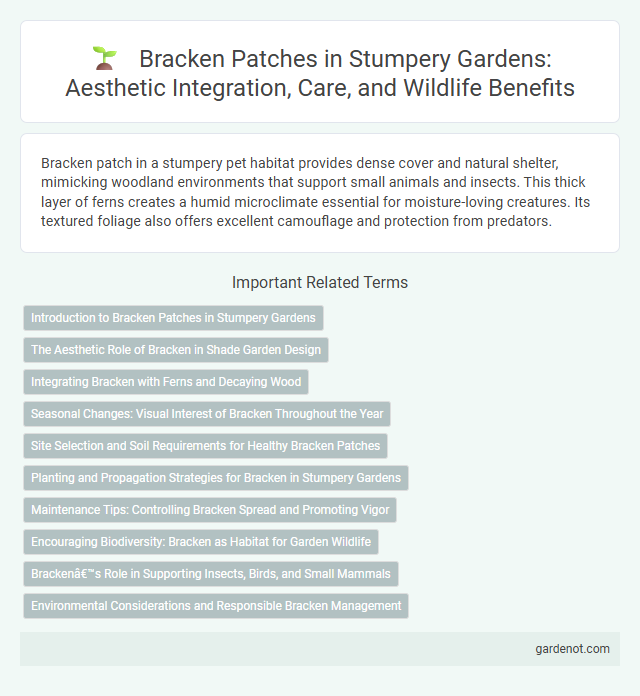Bracken patch in a stumpery pet habitat provides dense cover and natural shelter, mimicking woodland environments that support small animals and insects. This thick layer of ferns creates a humid microclimate essential for moisture-loving creatures. Its textured foliage also offers excellent camouflage and protection from predators.
Introduction to Bracken Patches in Stumpery Gardens
Bracken patches in stumpery gardens create a naturalistic ground cover that enhances woodland aesthetics and biodiversity. These dense clusters of Pteridium aquilinum provide shelter for small wildlife and retain soil moisture, promoting a healthy garden ecosystem. Integrating bracken into stumperies supports an authentic forest-floor ambiance while requiring minimal maintenance.
The Aesthetic Role of Bracken in Shade Garden Design
Bracken plays a crucial aesthetic role in shade garden design by providing lush, textured greenery that contrasts beautifully with darker woodland areas. Its broad, feathery fronds create a natural, layered effect that enhances depth and visual interest in shaded environments. The plant's resilience and rich green tones make it an ideal backdrop for highlighting delicate shade-loving flowers and ferns.
Integrating Bracken with Ferns and Decaying Wood
Bracken patch creates a dynamic habitat by integrating dense fronds with shade-loving ferns and layers of decaying wood, fostering biodiversity and enhancing soil health. The intertwining of bracken's robust structure with delicate fern foliage supports microhabitats for insects and small mammals, while decomposing wood enriches the nutrient cycle. This synergy promotes a sustainable ecosystem, crucial for woodland gardens and naturalistic stumpery designs.
Seasonal Changes: Visual Interest of Bracken Throughout the Year
Bracken patches transform vividly with each season, displaying fresh, bright green fronds in spring that unfurl with delicate grace. Summer deepens the bracken's lush texture, providing dense, rustling foliage that supports diverse wildlife. In autumn, bracken turns golden brown, adding warm, earthy tones and maintaining garden interest even as other plants fade.
Site Selection and Soil Requirements for Healthy Bracken Patches
Bracken patches thrive best in well-drained, acidic soils with a pH ranging from 4.5 to 6.0, favoring sites that receive partial shade to full sun exposure. Ideal locations include woodland edges, heathlands, and disturbed areas where organic matter is abundant to support robust rhizome growth. Careful site selection ensures optimal moisture retention and aeration, which are essential for the healthy development and spread of bracken ferns.
Planting and Propagation Strategies for Bracken in Stumpery Gardens
Planting bracken in stumpery gardens requires selecting shaded, moist, and well-drained soil to mimic its natural woodland habitat for optimal growth. Propagation is effectively achieved through rhizome division during early spring, ensuring vigorous new fronds and healthy clump establishment. Regular mulching with organic matter supports moisture retention and nutrient supply, enhancing bracken's resilience and aesthetic contribution to shady garden landscapes.
Maintenance Tips: Controlling Bracken Spread and Promoting Vigor
Regular cutting of bracken fronds before spore release effectively limits the plant's spread and reduces its competitive dominance. Applying targeted herbicides during active growth phases can weaken established rhizomes, enhancing control efforts. Encouraging grass and groundcover growth through selective thinning improves soil health and promotes a balanced ecosystem within the bracken patch.
Encouraging Biodiversity: Bracken as Habitat for Garden Wildlife
Bracken patch provides a dense, sheltered habitat ideal for a variety of garden wildlife, including insects, amphibians, and small mammals. Its large fronds create microclimates that support mosses, ferns, and invertebrates, enhancing local biodiversity effectively. Encouraging bracken in stumperies fosters ecological balance by offering a vital refuge and breeding ground for numerous species.
Bracken’s Role in Supporting Insects, Birds, and Small Mammals
Bracken provides vital habitat and shelter for various insects, including beetles and moths, which rely on its fronds for breeding and feeding. Birds such as wrens and robins use bracken patches for nesting sites and cover from predators. Small mammals like voles and shrews benefit from the dense undergrowth of bracken, which offers protection and abundant foraging opportunities.
Environmental Considerations and Responsible Bracken Management
Bracken patches require careful environmental consideration due to their invasive nature and impact on local biodiversity. Responsible bracken management involves regular cutting or grazing to prevent dense thickets that suppress native plants and reduce habitat diversity. Implementing controlled burns or mechanical removal methods helps maintain ecological balance while preserving soil health and preventing bracken dominance.
Bracken patch Infographic

 gardenot.com
gardenot.com